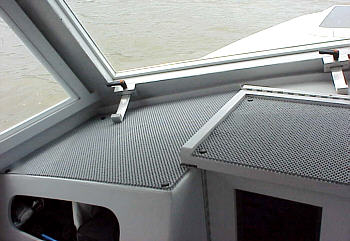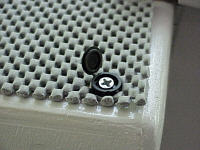| In the past several months I have made several minor modifications
to the Cabin Skiff and I thought it might be of interest to list them here.
 My
local dock is under the control of the Illinois Department of Conservation
and they have been working there to do some improvements. This is
good and bad. The good is when done the channel will be dredged and
new courtesy docks added. The bad news is that when they started
they pulled out the old docks. This was six months ago and since
then the only way to get to shore is to pull up on the concrete ramp.
The sound of fiberglass and or wood scraping on concrete is not pleasant.
I grit my teeth every time! My
local dock is under the control of the Illinois Department of Conservation
and they have been working there to do some improvements. This is
good and bad. The good is when done the channel will be dredged and
new courtesy docks added. The bad news is that when they started
they pulled out the old docks. This was six months ago and since
then the only way to get to shore is to pull up on the concrete ramp.
The sound of fiberglass and or wood scraping on concrete is not pleasant.
I grit my teeth every time!
After fighting this for a couple of months thinking they would get
it fixed I finally decided to add a “keel guard” to protect the hull. These
are offered by several companies in various colors and lengths. Measuring
confirmed that a 5’ unit would work just fine and run from the bow eye
to the front of the skeg. I purchased a dark blue one from one of
the mail order houses for about $110. Application was fairly easy
and I am pleased with the result.
In addition to this I also added a 1” x 16” x 1/8” piece of aluminum
to the front of the skeg. I found that on shallower ramps and landings
that the skeg would hit before the keel guard. I attached it with
three countersunk wood screws and waterproof sealant. I plan to keep
and eye on it and if it starts to wear appreciably I will replace with
a strip if stainless.
 Another
item I decided to add are chafe guards at the cleats. I have noticed that
the Easypoxy paint is somewhat easy to damage and when the ropes pulled
tight they scuff against the deck edge (Note scratch! This could be result
of my use of automotive primer under paint). The biggest problem
was when using the bow cleats for the anchor rope. I bought some 1/2”
diameter aluminum rod and machined an edge flat. Using countersunk screws
I attached these to the deck in front of the cleat. It may not look the
best but it works. I thought about painting them but the paint would
probably be rubbed off them too. Another
item I decided to add are chafe guards at the cleats. I have noticed that
the Easypoxy paint is somewhat easy to damage and when the ropes pulled
tight they scuff against the deck edge (Note scratch! This could be result
of my use of automotive primer under paint). The biggest problem
was when using the bow cleats for the anchor rope. I bought some 1/2”
diameter aluminum rod and machined an edge flat. Using countersunk screws
I attached these to the deck in front of the cleat. It may not look the
best but it works. I thought about painting them but the paint would
probably be rubbed off them too.

The top of the instrument panel, glove box area and berth hatch
seems to be a catch-all area when cruising. Things like sunglasses,
binoculars, pencils and cameras all seem to get tossed up there. Sitting
directly on the wooden top they tend to rattle around and slide off.
I wanted to add some type of a non-skid surface to help hold them in place.
I had a couple of different things in mind but settled on a foam rubber
type shelf lining material made for kitchen cabinets and tool box drawers.
It is inexpensive and available at WalMart and most hardware stores.
 I
attached it with wood screws set in plastic caps that snap closed hiding
the screw head (common hardware store item). These not only add to
the appearance but create a larger head to hold the lining in place. I
attached it with wood screws set in plastic caps that snap closed hiding
the screw head (common hardware store item). These not only add to
the appearance but create a larger head to hold the lining in place.
The foam material has worked very well. It cushions anything
sitting up there and really grips keeping things form sliding off.
I have left my binoculars on top of the hatch while running on very rough
water and they have never slid off.
BACK NEXT
|
 My
local dock is under the control of the Illinois Department of Conservation
and they have been working there to do some improvements. This is
good and bad. The good is when done the channel will be dredged and
new courtesy docks added. The bad news is that when they started
they pulled out the old docks. This was six months ago and since
then the only way to get to shore is to pull up on the concrete ramp.
The sound of fiberglass and or wood scraping on concrete is not pleasant.
I grit my teeth every time!
My
local dock is under the control of the Illinois Department of Conservation
and they have been working there to do some improvements. This is
good and bad. The good is when done the channel will be dredged and
new courtesy docks added. The bad news is that when they started
they pulled out the old docks. This was six months ago and since
then the only way to get to shore is to pull up on the concrete ramp.
The sound of fiberglass and or wood scraping on concrete is not pleasant.
I grit my teeth every time!
 Another
item I decided to add are chafe guards at the cleats. I have noticed that
the Easypoxy paint is somewhat easy to damage and when the ropes pulled
tight they scuff against the deck edge (Note scratch! This could be result
of my use of automotive primer under paint). The biggest problem
was when using the bow cleats for the anchor rope. I bought some 1/2”
diameter aluminum rod and machined an edge flat. Using countersunk screws
I attached these to the deck in front of the cleat. It may not look the
best but it works. I thought about painting them but the paint would
probably be rubbed off them too.
Another
item I decided to add are chafe guards at the cleats. I have noticed that
the Easypoxy paint is somewhat easy to damage and when the ropes pulled
tight they scuff against the deck edge (Note scratch! This could be result
of my use of automotive primer under paint). The biggest problem
was when using the bow cleats for the anchor rope. I bought some 1/2”
diameter aluminum rod and machined an edge flat. Using countersunk screws
I attached these to the deck in front of the cleat. It may not look the
best but it works. I thought about painting them but the paint would
probably be rubbed off them too.

 I
attached it with wood screws set in plastic caps that snap closed hiding
the screw head (common hardware store item). These not only add to
the appearance but create a larger head to hold the lining in place.
I
attached it with wood screws set in plastic caps that snap closed hiding
the screw head (common hardware store item). These not only add to
the appearance but create a larger head to hold the lining in place.